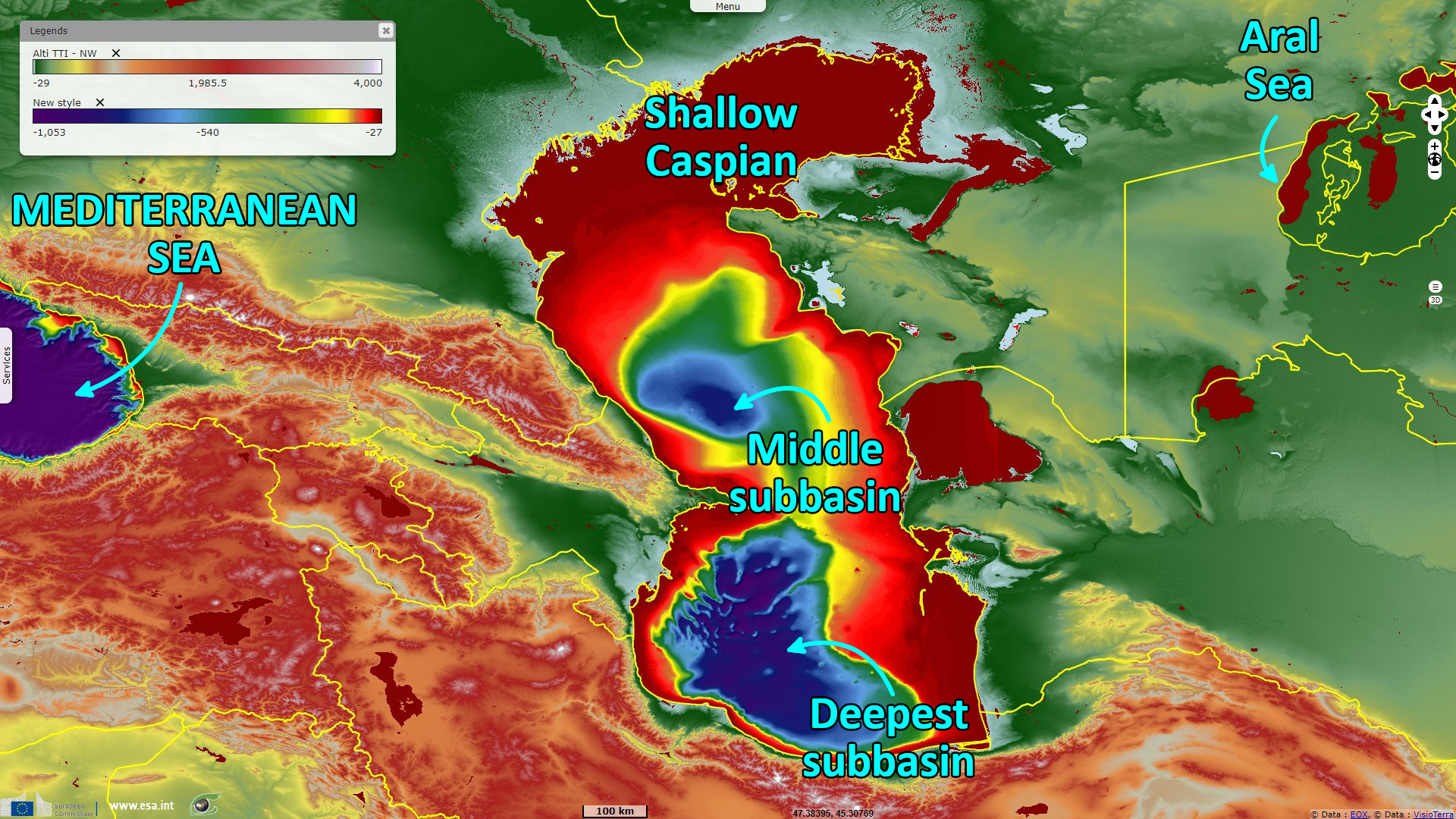Multicoloured water on the Caspian Sea
Sentinel-3 OLCI FR acquired on 31 January 2023 at 06:54:56 UTC
...
Sentinel-2 MSI acquired on 05 July 2023 at 07:46:19 UTC
Sentinel-3 OLCI FR acquired on 06 July 2023 from 06:13:00 to 07:15:02 UTC
...
Sentinel-2 MSI acquired on 05 July 2023 at 07:46:19 UTC
Sentinel-3 OLCI FR acquired on 06 July 2023 from 06:13:00 to 07:15:02 UTC
Keyword(s): Water colour, endorheic basin, lake, biodiversity, agriculture, pollution, algal bloom, sediment, alluvium, Russia, Kazakhstan, Azerbaijan, Iran, Turkmenistan
The Caspian Sea is a vast body of water in western Asia, fed mainly by the Volga. It is bordered to the north and east by the steppes of Central Asia, and to the west and south by the Himalayan and Alpine orogeny chains: the Caucasus and Elbourz respectively. The sea is bordered by Russia and Kazakhstan to the north, Azerbaijan to the west, Turkmenistan to the east and Iran to the south.
The Caspian Sea is the largest landlocked body of water in the world. Its maximum length is 1030 km in a north-south direction, and its maximum width is 435 km east-west. The maximum depth of the Caspian Sea is 1025 m.
The Caspian Sea contains more than 78 000 km3 of water-about one-third of Earth's inland surface water. The elongated, almost tide-free sea fills a deep depression (some 27 m below sea level) between Europe and Asia.
From a geological, hydrographic and historical point of view, the Caspian Sea is the result of the closure of the Paratethys Ocean or Sea. It is the largest enclosed sea in the world. It became isolated from the ancient Paratethys about 5.5 million years ago, as a result of the tectonic uplift of the Caucasus and the fall in sea levels (marine regression).
During the Pliocene, the ancient Paratethys was subdivided into several inland seas that eventually became disconnected from one another. This was particularly true of the Pannonian Sea, an inland sea that occupied the present-day Pannonian plain. Most of these enclosed seas disappeared at the end of the Pleistocene. Today, only the Black Sea, the Caspian Sea and the Aral Sea remain.
Regarding biodiversity in the lake, "The number of endemic aquatic taxa is over 400. Of 124 species of molluscs, 119 are endemic or subendemic. There are 115 species of fish, of which many are anadromous and migrate from the Caspian up the rivers to spawn. The endemic Caspian seal is one of only two existing freshwater seal species (the other is found in Lake Baikal). The sea coast provides many important sites for a number of nesting and migratory birds.", wrote Mark McGinley, assistant Dean in the Honors College and Associate Professor in the Department of Biological Sciences at Texas Tech University in the Encyclopedia of Earth.
"The Caspian has been separated from the other seas since the last glacial period. It has not only preserved the rich late Tertiary flora and fauna but has also been influenced by later inputs, particularly of freshwater origin. The Caspian Sea is noted for a great number of endemic species of fauna. It is considered an independent zoogeographical region due to the diversity, specificity and endemism of its fauna."
"Most of the Caspian fish endemics belong to the herring and bullhead families of which seven species and subspecies of sturgeon are of importance. The Caspian is the only area with a significant sturgeon fishery, which represents up to 90% of the world catch."
"The Caspian Lowland lies on the northern and eastern shores of the Caspian Sea at elevations between -28 to 100 meters above sea level. Four rivers traverse the region on their way to the Caspian Sea: Volga, Ural, and Emba from the north, and Atrek from the southeast. The shelf area of the sea adjacent to the Caspian shore is very shallow: the 10 m isobathe extends 10 to 20 kilometers from shore. The coastal zone is built of Tertiary and Quaternary sea sediments."
"In the northern section of this ecoregion, typical mammals include wild boar, otter, weasel, brown hare, wild rabbit, muskrat, many semi-desert rodents. Two species introduced from American are quite common: nutria and raccoon."
The Northern part of the lake is a wetland protected by the Ramsar convention. Its sheet states: "A unique river delta wetland in western Kazakhstan along the northern shore of the Caspian Sea, comprising a large variety of marine/coastal and inland wetland types. Due to its mixed water supply and seasonal variation, the site has a range of marine and freshwater habitats and supports considerable numbers and diversity of species, notably 13 IUCN threatened bird species."
"The site is significant for large numbers of nesting, moulting and migratory species, among them appreciable numbers of Mute Swan (22 000), Mallard (12 000) and Teal (44 000). The Ural River is significant as a spawning ground for a number of Caspian Sea sturgeon fish species. The site supports more than 460 species of vertebrate animals, including 76 species of fish, 20 species of reptile, 292 bird species and 48 species of mammals."
"The north coast of the Caspian Sea is characterized by the large development of damp sites resulting from tidal phenomena. The depression is also home to many insect species, with several thousand different species likely living in the region around the Caspian Sea. Studies have shown that water pollution, mostly coming from the Volga River, poses a serious threat to the biodiversity of the Caspian Depression. Water pollution is contributed mainly by industrial, agricultural, and household discharges."
















